Verification of the Non-Axisymmetric Deformation Mechanism of Bearing Rings after Quenched in a Multi-Field Coupled Simulation
Abstract
:1. Introduction
2. Experimental Procedure
2.1. Heat-Treatment Process
2.2. Measurement of Cooling Curves
2.3. Identification of Heat Transfer Coefficient
2.4. Numerical Simulation Program
2.5. Material Analysis
3. Results and Discussion
4. Conclusions
- With applied orthogonal symmetrical heat transfer, the ellipticity was 0.14 mm, and with applied external orthogonal symmetrical and internal axial symmetry heat transfer, the ellipticity was 0.158 mm. The experimental value was 0.83–0.96 mm, and both are closer to the experimental situation. This indicates that the simulation solution is appropriate and that the assumption of the heat transfer boundaries is reasonable.
- By using one or more heat transfer boundary conditions on the surfaces of the bearing outer rings, we achieved a simulation of the bearing outer ring, and, thus, experimental results were compared. From the analysis of the temperature and deformation results by setting the same heat transfer boundary condition, temperature cooling from the outside to inside was reflected; with the center cooling the slowest, where the resulting deformation appeared more uniform and, therefore, this part showed little elliptical form after quenching.
- When different heat transfer boundary conditions are applied to the two sets of orthogonal symmetrical surfaces of the bearing outer ring, heat from the bearing outer ring makes the oil film on its surfaces reach a boiling state in succession until the film of the surface breaks in order. The rupture of the steam film has a time difference; it causes the formation of temperature gradients and creates orthogonal residual stress in the annular direction, which ultimately makes the bearing outer ring occur with non-axisymmetric deformation, generating shape tolerances for ellipticity. By comparing the experimental results, the results of the simulation analysis were verified.
- According to the research in this paper, it can be demonstrated that improving the uniformity of the heat transfer coefficient in the circumferential direction is key to avoiding elliptical deformation of the bearing. For this reason, our suggestion is to increase the stirring cooling method in the oil tank, so that the heat transfer coefficient in the circumferential direction of the bearing is more uniform, therefore making it possible to reduce elliptical deformation.
Author Contributions
Funding
Institutional Review Board Statement
Informed Consent Statement
Data Availability Statement
Acknowledgments
Conflicts of Interest
References
- Chidester, A.J.; Darrang, C.V.; Hoff, R.C.; Imundo, J.R.; Maloney, J.L. Heat Treatment of Bearings; ASM International: Almere, The Netherlands, 2014; Volume 4. [Google Scholar]
- Zhang, X.; Li, Z.; Cui, X. Numerical simulation on heat treatment deformation of GCr15 bearing rings. Bearing 2020, 11, 45–49. [Google Scholar]
- Xue, M. Effect of austenitization condition on microstructure of hypereutectoid steel. Foundry Technol. 2014, 12, 2857–2859. [Google Scholar]
- Narazaki, M.; Shichino, H.; Sugimoto, T.; Watanabe, Y. Validation of Estimate Heat Transfer Coefficients during Quenching of Steel Gear. In Proceedings of the Fifth International Conference on Quenching and the Control of Distortion, Berlin, Germany, 23–25 November 2007; pp. 111–117. [Google Scholar]
- Inoue, T.; Ju, D.Y.; Arimoto, K. Metallo-Thermo-Mechanical Simulation of Quenching Process-Theory and Implementation of Computer Code “Hearts”. In Proceedings of the First International Conference on Quenching and Distortion Control, Chicago, IL, USA, 22–25 September 1992; pp. 205–212. [Google Scholar]
- Ju, D.-Y.; Inoue, T. On the material process simulation code COSMAP simulated examples and its experimental verification for heat treatment process. Mech. Behav. Mater. X 2007, 345–346, 955–958. [Google Scholar]
- Deng, X.; Ju, D.Y. Modeling and Simulation of Quenching and Tempering Process in steels. In Proceedings of the International Federation for Heat Treatment and Surface Engineering 20th Congress, Beijing, China, 23–25 October 2012; pp. 23–25. [Google Scholar]
- Ju, D.Y.; Zhang, W.M. Modeling and experimental verification of plastic behavior of the martensitic transformation plastic behavior in a carbon steel heat treatment of materials. Solid State Phenom. 2006, 118, 369–374. [Google Scholar] [CrossRef]
- Watanabe, Y.; Ju, D.Y. Cooperative research to optimize heat treating process condition by computer based technology. Heat Treat. Mater. 2006, 118, 349–354. [Google Scholar]
- Maio, S.; Wang, J. Improvement and analysis of fatigue strength for mild steel 20MnCrS5 during carburizing and quenching. Mater. Sci. (Medžiagotyra) 2020, 26, 192–198. [Google Scholar] [CrossRef] [Green Version]
- Miao, S.; Ju, D.Y.; Chen, Y.; Liu, L. Optimization based on orthogonal experiment design and numerical simulation for carburizing quenching process of helical gear. Mater. Perform. Charact. 2019, 8, 66–79. [Google Scholar] [CrossRef]
- Xusheng, L.; Dongying, J.; Jianting, C.; Sirui, W.; Yong, C.; Fangbo, H.; Hui, L. Effect of transformation plasticity on gear distortion and residual stresses in carburizing quenching simulation. Coatings 2021, 11, 1224. [Google Scholar] [CrossRef]
- Wang, J.; Yang, S.; Li, J.; Ju, D.; Li, X.; He, F.; Li, H.; Chen, Y. Mathematical Simulation and experimental verification of carburizing quenching process based on multi-field coupling. Coatings 2021, 11, 1132. [Google Scholar] [CrossRef]
- Li, M.; Deng, K.; Deng, S.; Kang, N. FEM analysis of a new type hub bearing rings during quenching. Bearing 2017, 1, 24–28. [Google Scholar]
- Yiyu, S.; Wenfei, P.; Shaoqiang, C. Effect of cold treatment process on roundness of bearing ring. Mater. Res. Express 2022, 9, 026513. [Google Scholar]
- Zhaoxi, C.; Zhiyue, S.; Feng, Y.K.S.; Wenquan, C.; Yuqing, W. Effects of double quenching on fatigue properties of high carbon bearing steel with extra-high purity. Int. J. Fatigue 2019, 128, 11. [Google Scholar]
- Xiaohui, L.; Dongsheng, Q.; Wei, L.; Xuejun, J. Enhanced toughness of bearing steel by combining prior cold deformation with martensite pre-quenching and bainite transformation. Mat. Lett. 2019, 234, 5–8. [Google Scholar]
- Kai, Z.; Baiqing, X.; Xiwu, L.; Yongan, Z.; Li, Z.; Li, Y.; Wen, K.; Yan, L. Finite element simulation on residual stress during immersion quenching and pre-stretching of Al7055 thick plates. Mater. Res. Express 2022, 9, 026525. [Google Scholar]
- Wu, H.Y.; Han, D.X.; Du, Y.; Gao, X.H.; Du, L.X. Effect of initial spheroidizing microstructure after quenching and tempering on wear and contact fatigue properties of GCr15 bearing steel. Mater. Today Commun. 2022, 30, 3. [Google Scholar] [CrossRef]
- Chang, G.; Liu, X.; Chen, C.; Ren, R. Calculation of the heat transfer coefficient of GCr15 steel in quenching process. Mater. Guide 2013, 21, 120–122. [Google Scholar]
- Ju, D.Y.; Ichtani, K.; Nakamura, E.; Mukai, R. Heat treatment and surface engineering. AIM 1998, 2, 283–291. [Google Scholar]
- Kanamori, H.; Ju, D.Y. Identification of heat transfer coefficients and simulation of quenching distortions on disk probe. Mater. Trans. 2020, 61, 884–892. [Google Scholar] [CrossRef]
- Saunders, N.; Guo, U.K.Z.; Li, X.; Miodownik, A.P.; Schillé, J.-P. Using JMatPro to model materials properties and behavior, Industrial Insight. JOM 2003, 55, 60–65. [Google Scholar] [CrossRef]

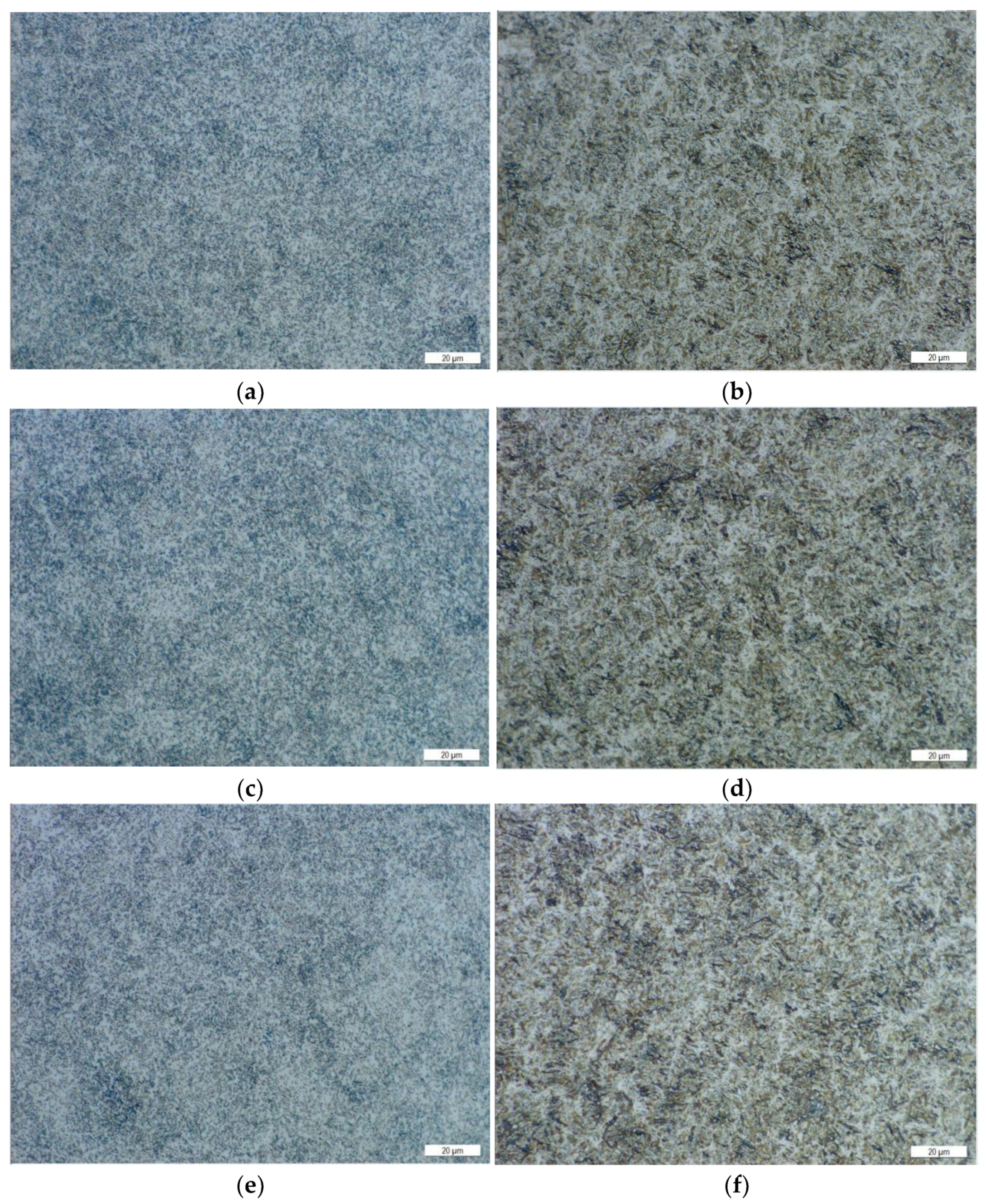

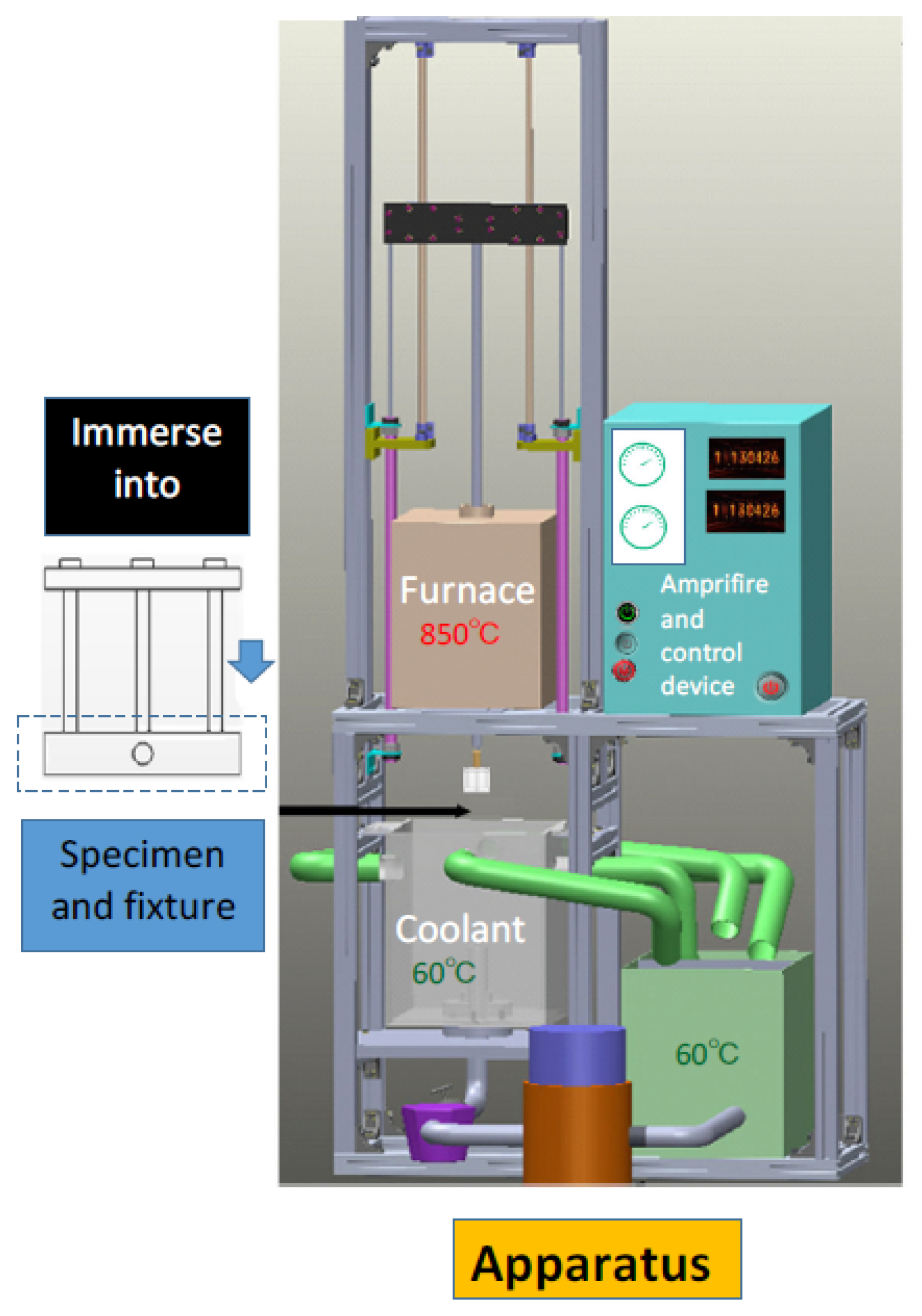
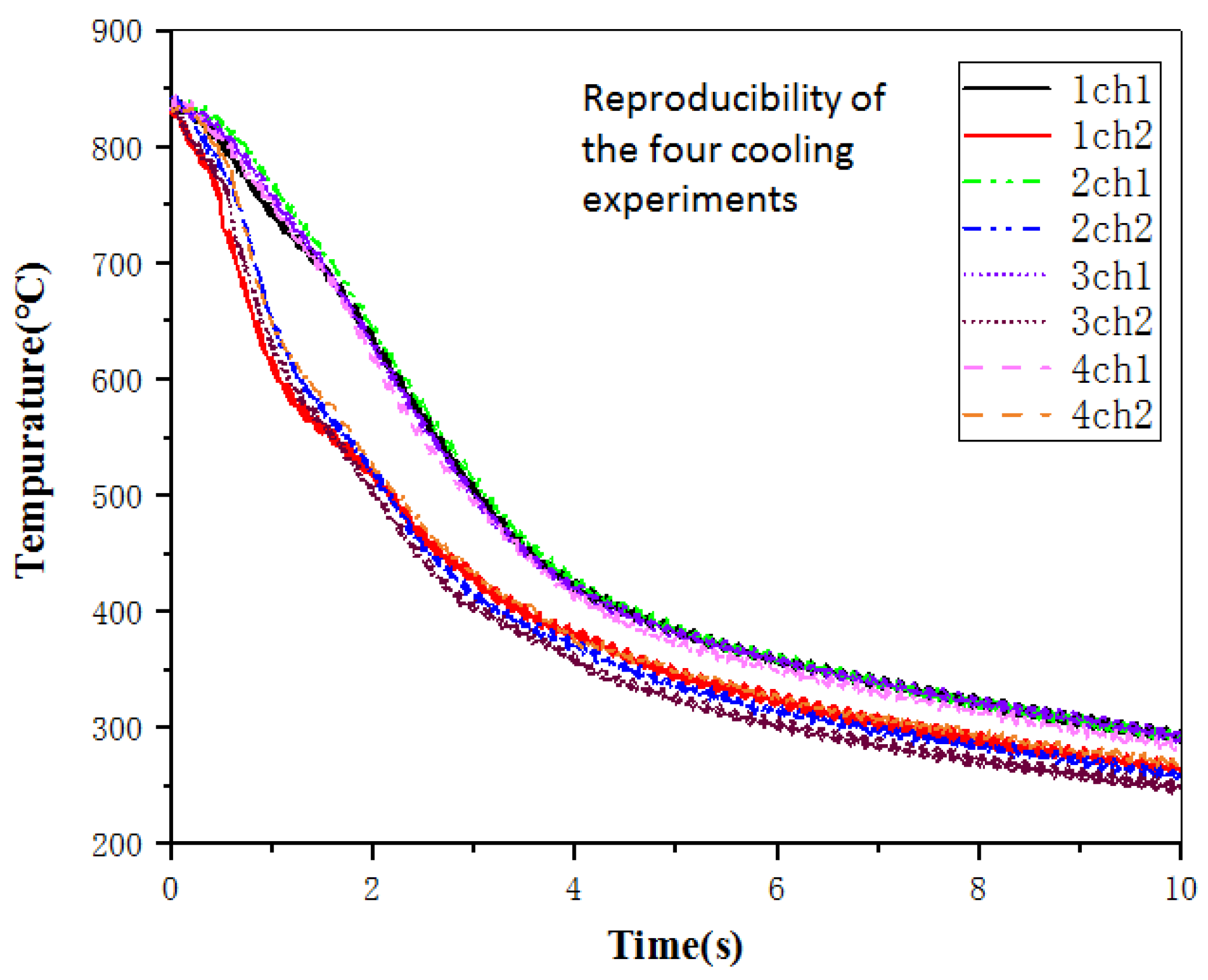
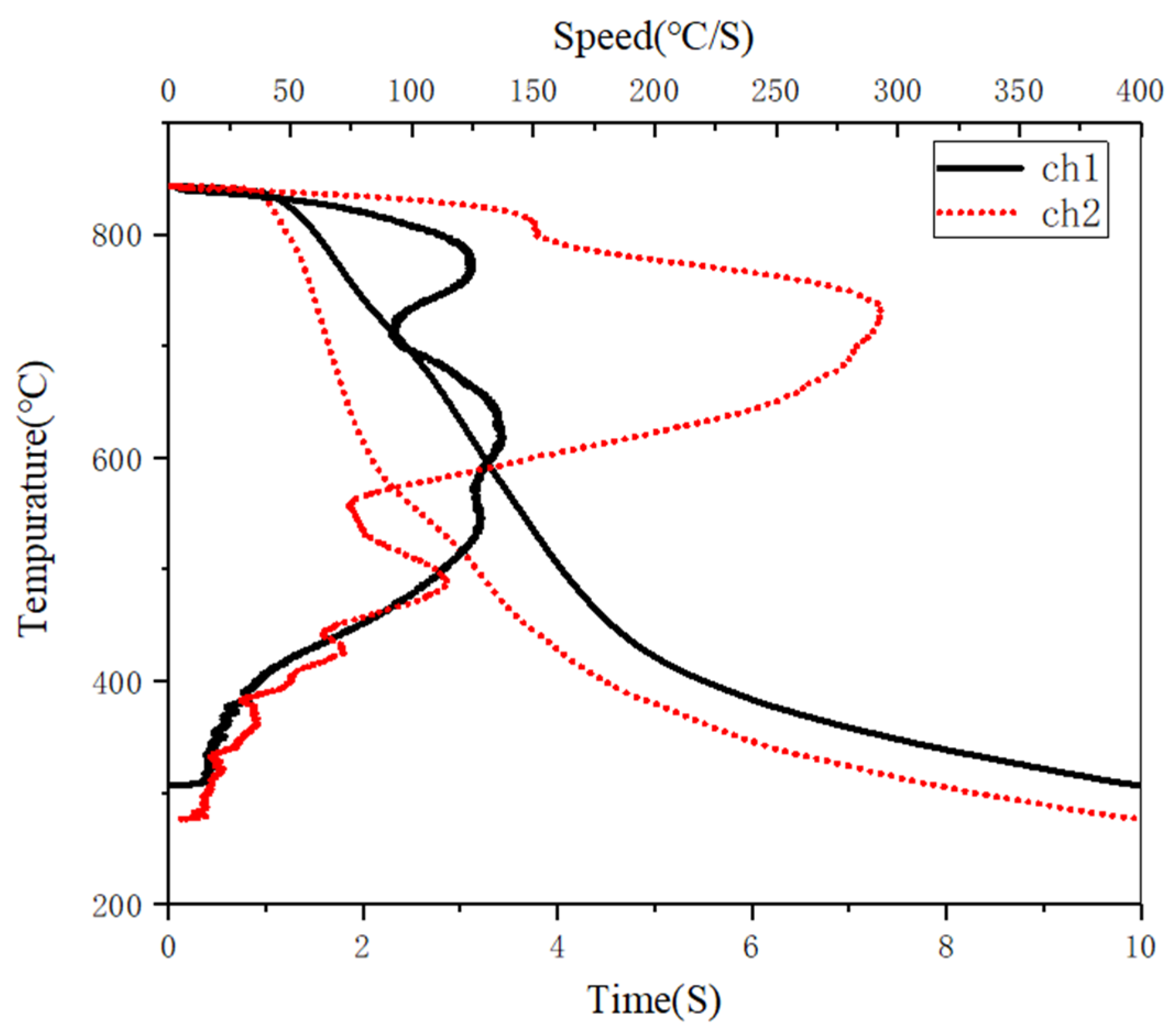
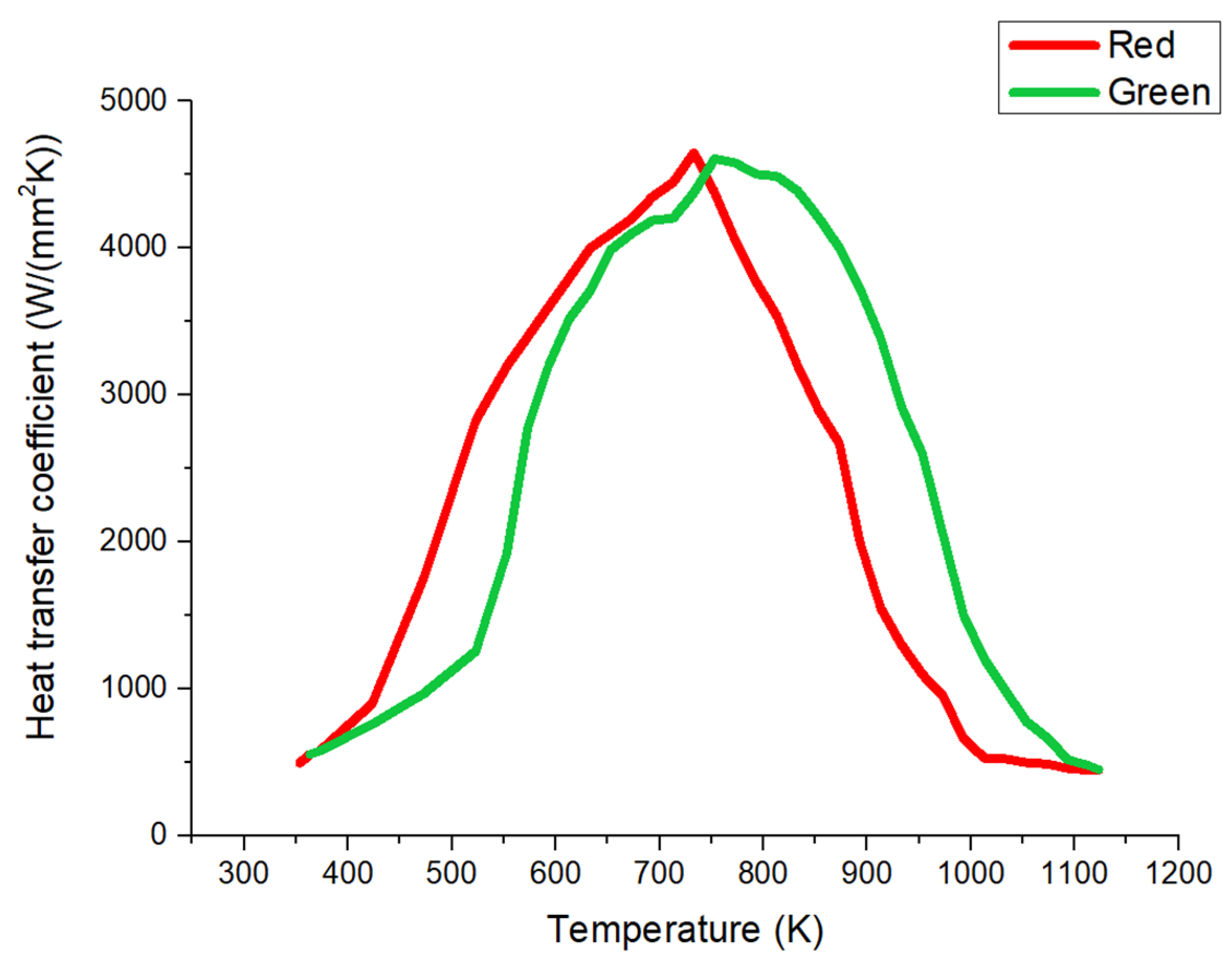
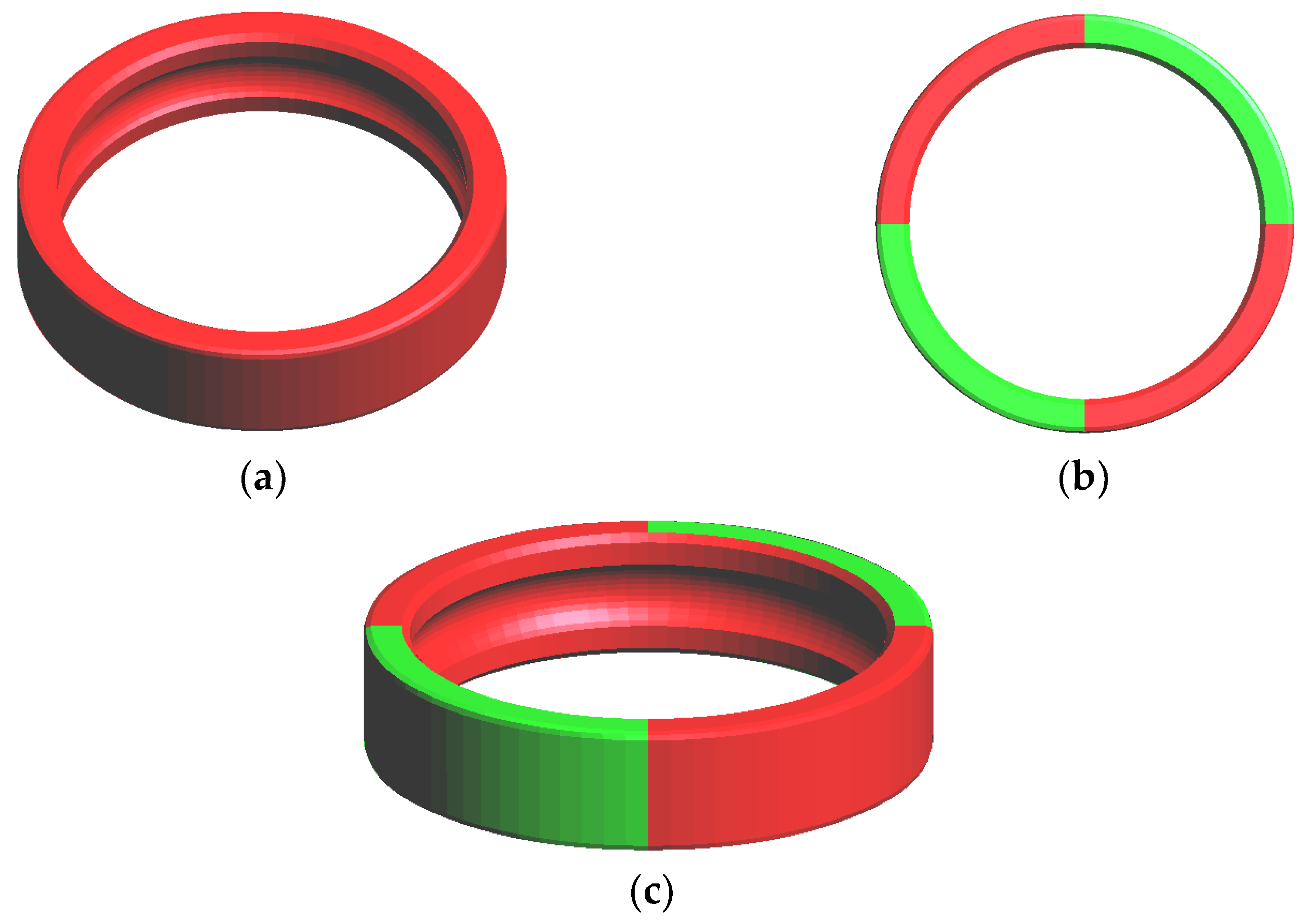




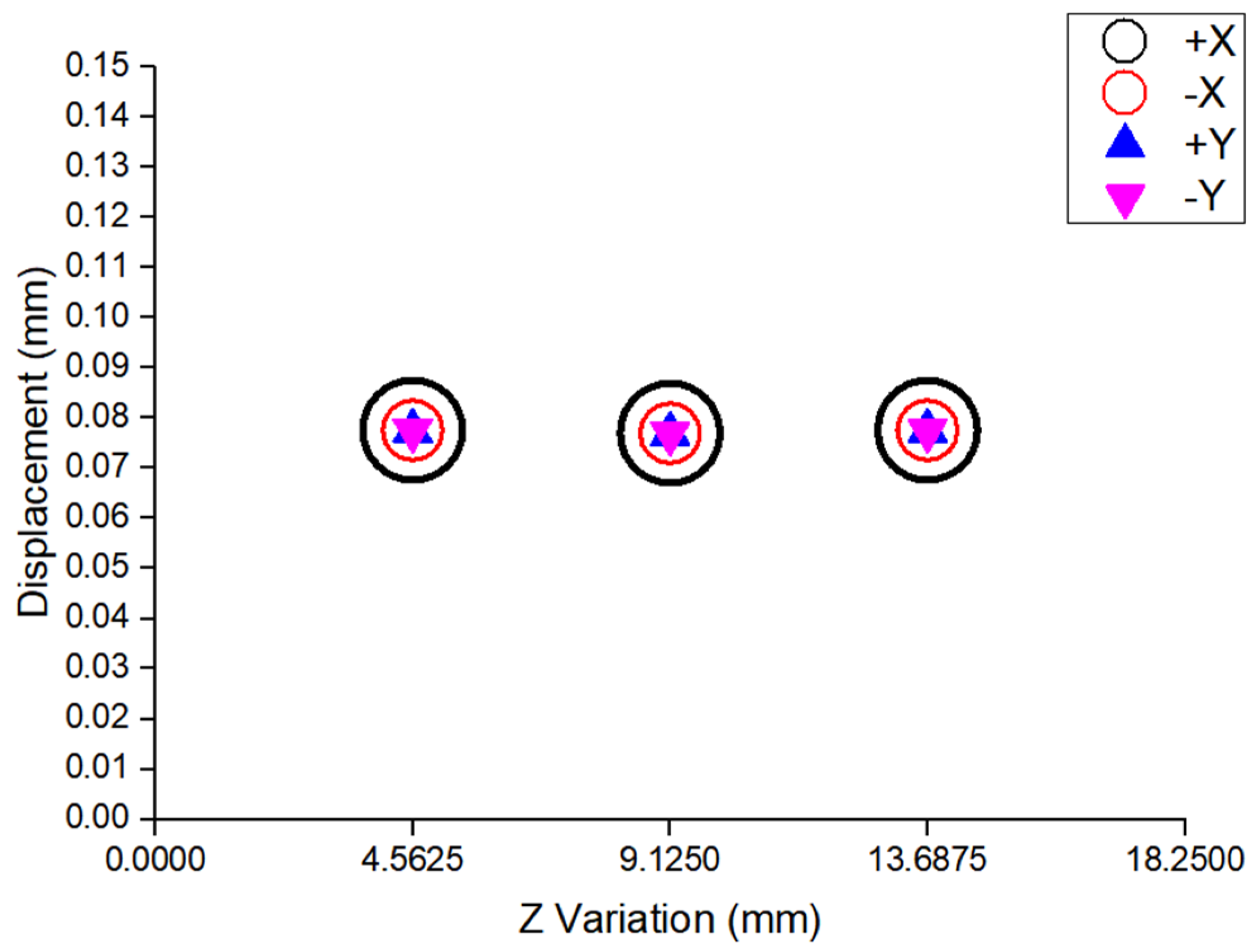

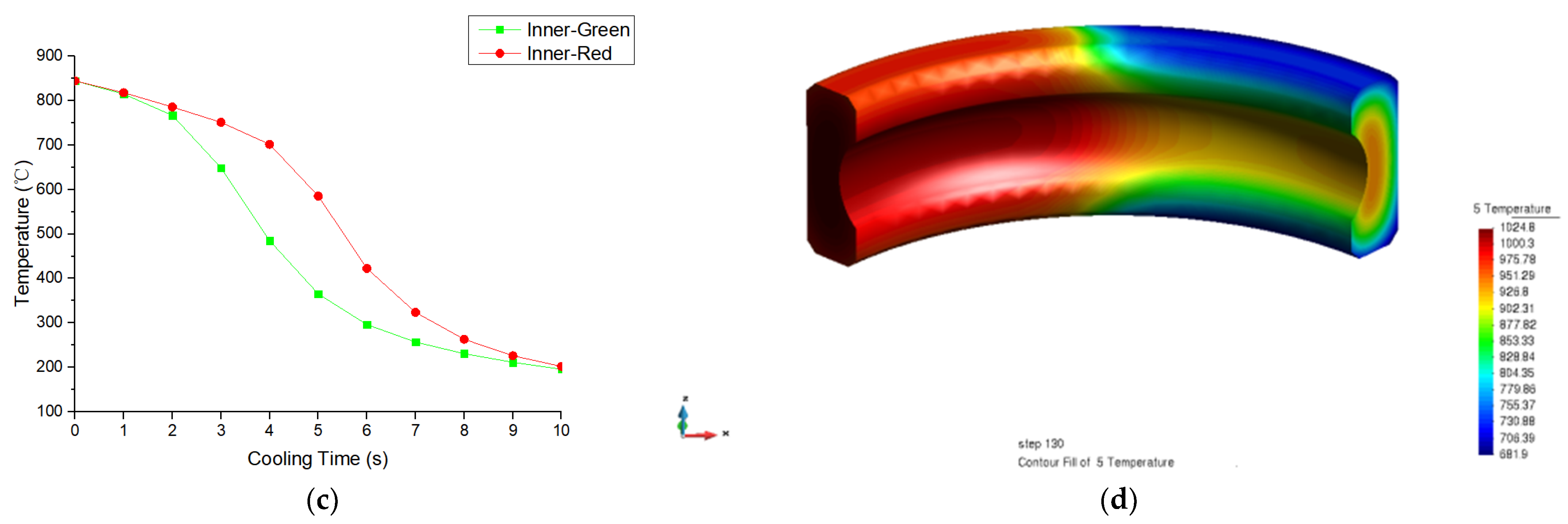
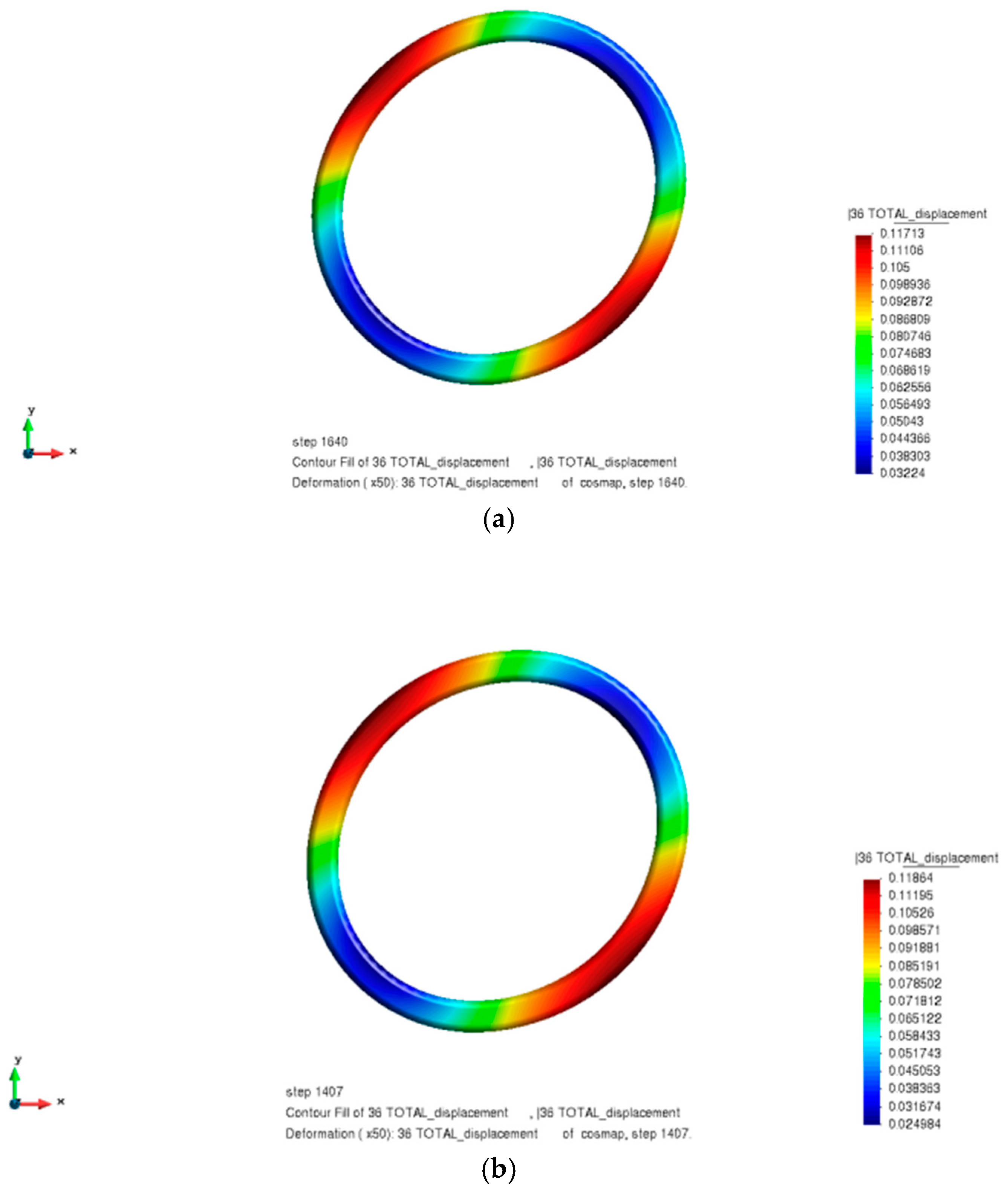

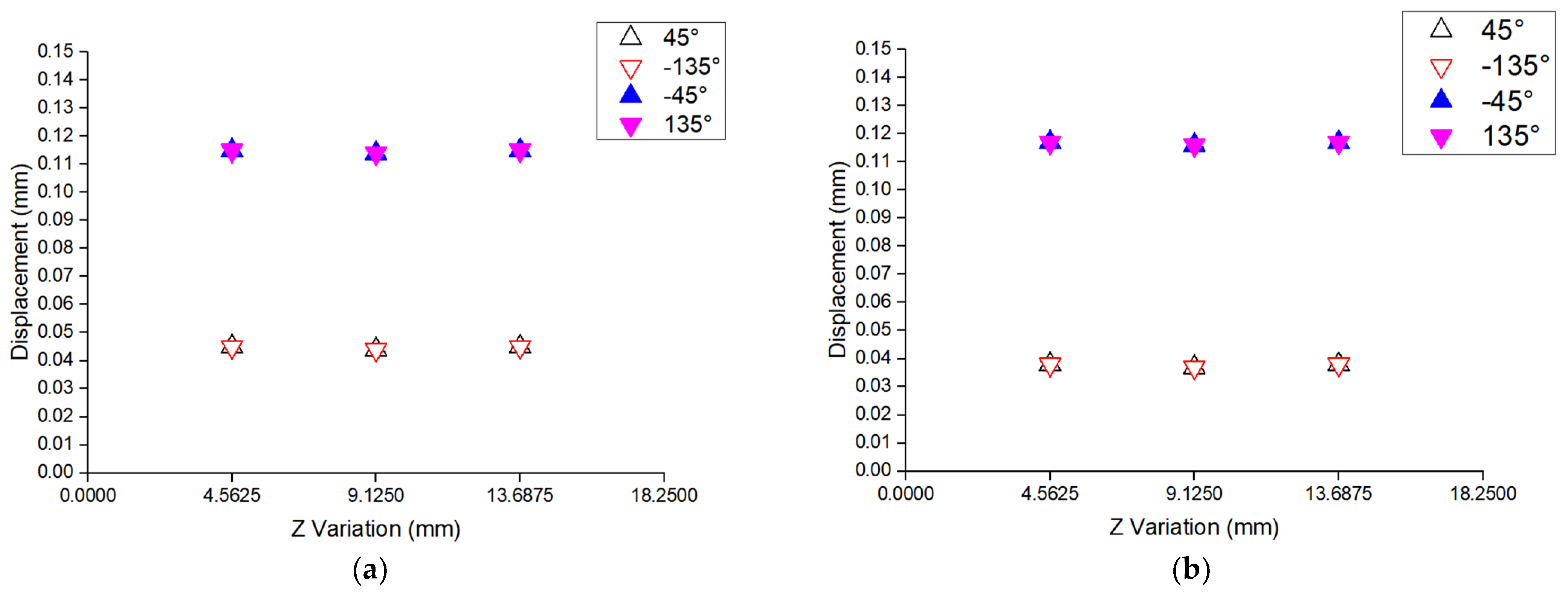
| Z Variation | First Experiment | Second Experiment | Third Experiment | Experimental Average Value |
|---|---|---|---|---|
| 3/4H | 0.11 | 0.10 | 0.08 | 0.096 |
| 1/2H | 0.11 | 0.10 | 0.07 | 0.093 |
| 1/4H | 0.10 | 0.07 | 0.08 | 0.083 |
| Number | Outer Surface before Quenching | Outer Surface after Quenching | Internal Surface before Quenching | Internal Surface after Quenching | Inner Surface before Quenching | Inner Surface after Quenching |
|---|---|---|---|---|---|---|
| 1 | 189 | 792 | 192 | 795 | 195 | 802 |
| 2 | 192 | 795 | 190 | 795 | 195 | 793 |
| 3 | 190 | 793 | 190 | 794 | 193 | 802 |
| Average | 190.33 | 793.33 | 190.67 | 794.67 | 194.33 | 800.67 |
| Fe | C | Si | Mn | Cr | Cu | Mo | Ni + Cu | P | S |
|---|---|---|---|---|---|---|---|---|---|
| Bal. | 0.95~1.05 | 0.15~0.35 | 0.25~0.45 | 1.4~1.65 | ≤0.25 | ≤0.1 | ≤0.5 | ≤0.025 | ≤0.025 |
| Bainite Coefficient of Phase Expansion | Martensite Coefficient of Phase Expansion | Bainite Coefficient of Phase Plasticity | Martensite Coefficient of Phase Plasticity |
|---|---|---|---|
| 2.01 × 10−3 | 5.03 × 10−3 | 9.952 × 10−5 | 7.519 × 10−5 |
| Quarter Height of Part | Half-Height of Part | Three-Quarter Height of Part |
|---|---|---|
| 0.0002 | 0.0002 | 0.0002 |
| Z Variation | Orthogonal | External Orthogonal Internal Symmetric |
|---|---|---|
| 3/4H | 0.14 | 0.158 |
| 1/2H | 0.14 | 0.158 |
| 1/4H | 0.14 | 0.158 |
Publisher’s Note: MDPI stays neutral with regard to jurisdictional claims in published maps and institutional affiliations. |
© 2022 by the authors. Licensee MDPI, Basel, Switzerland. This article is an open access article distributed under the terms and conditions of the Creative Commons Attribution (CC BY) license (https://creativecommons.org/licenses/by/4.0/).
Share and Cite
Liu, Q.; Ju, D.; Li, X.; Ishikawa, K.; Lv, R.; Lian, W.; Zhang, M. Verification of the Non-Axisymmetric Deformation Mechanism of Bearing Rings after Quenched in a Multi-Field Coupled Simulation. Coatings 2022, 12, 676. https://doi.org/10.3390/coatings12050676
Liu Q, Ju D, Li X, Ishikawa K, Lv R, Lian W, Zhang M. Verification of the Non-Axisymmetric Deformation Mechanism of Bearing Rings after Quenched in a Multi-Field Coupled Simulation. Coatings. 2022; 12(5):676. https://doi.org/10.3390/coatings12050676
Chicago/Turabian StyleLiu, Qian, Dongying Ju, Xusheng Li, Kousuke Ishikawa, Rui Lv, Weifeng Lian, and Min Zhang. 2022. "Verification of the Non-Axisymmetric Deformation Mechanism of Bearing Rings after Quenched in a Multi-Field Coupled Simulation" Coatings 12, no. 5: 676. https://doi.org/10.3390/coatings12050676
APA StyleLiu, Q., Ju, D., Li, X., Ishikawa, K., Lv, R., Lian, W., & Zhang, M. (2022). Verification of the Non-Axisymmetric Deformation Mechanism of Bearing Rings after Quenched in a Multi-Field Coupled Simulation. Coatings, 12(5), 676. https://doi.org/10.3390/coatings12050676





